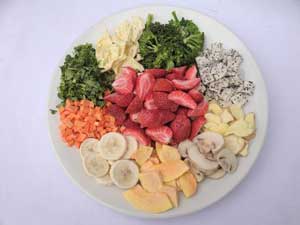Have you wondered what the difference is between freeze dried food storage and dehydrated food? Don’t worry, you’re not the only one.
Freeze Drying
 Freeze drying is the process of freezing water out of food and then quickly turning it into a gas—completely bypassing the liquid stage. Most fruit and vegetables are made up of 90% water, making freeze drying the best method to drastically shrink the volume of the food. Once the freeze drying process is completed, the water, (up to 90% of a product like strawberries), is effectively removed thus making the product much lighter but maintaining most of its original shape, color, flavor, and nutrients.
Freeze drying is the process of freezing water out of food and then quickly turning it into a gas—completely bypassing the liquid stage. Most fruit and vegetables are made up of 90% water, making freeze drying the best method to drastically shrink the volume of the food. Once the freeze drying process is completed, the water, (up to 90% of a product like strawberries), is effectively removed thus making the product much lighter but maintaining most of its original shape, color, flavor, and nutrients.
Freeze-drying is also the best process for maximizing shelf life. It only takes 5-10 minutes to rehydrate freeze dried food. You can do it with cold water but boiling water better unlocks the flavor and texture of the food. You’ll need a good heat source, so check out our reviews here.
Dehydration
 Dehydration is a method used to preserve fruit, vegetables and animal proteins. It is usually accomplished through the use of a food dehydrator. A food dehydrator uses a heat source and air flow to reduce the water content of foods. The water content of food is usually very high, typically 80% to 95% for various fruits and vegetables and 50% to 75% for meats.
Dehydration is a method used to preserve fruit, vegetables and animal proteins. It is usually accomplished through the use of a food dehydrator. A food dehydrator uses a heat source and air flow to reduce the water content of foods. The water content of food is usually very high, typically 80% to 95% for various fruits and vegetables and 50% to 75% for meats.
Removing moisture from food restrains various bacteria from growing and spoiling food. Further, removing moisture from food dramatically reduces the weight of the food.
Which is Better?
Honestly, the only reason freeze drying food is better than dehydration is that freeze drying can preserve animal products for 25+ years, whereas dehydration only preserves animal products for 5-10. So just make sure when you buy food storage you are getting real animal products that have been freeze dried. Too many companies try to say their dehydrated food last 25+ years when in fact, it doesn’t.






